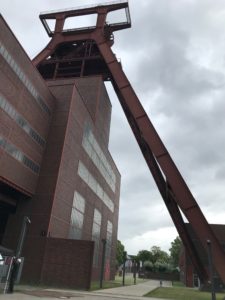In which Sid and Doris visit a huge industrial complex and make for the ferry without touching Holland.
The Zollverein mine has been going since the 1850s. What we want to see is the area around shaft twelve. This was all built to one plan by architects Fritz Schupp and Martin Kremmer between 1928 and 1932 in a Bauhaus style. The winding tower became a symbol of German heavy industry. The huge site also has a coking plant and though the mine stopped producing in 1986 the coking plant kept going to 1993.
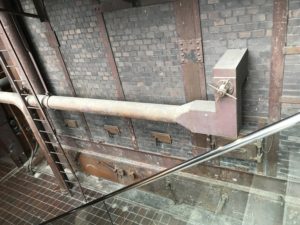

 The old boiler house has been converted into a design museum which we visit until time for our tour of the works. There are displays of very thin PCs which contrast well with the extraordinary massiveness of everything else on the site.
The old boiler house has been converted into a design museum which we visit until time for our tour of the works. There are displays of very thin PCs which contrast well with the extraordinary massiveness of everything else on the site.


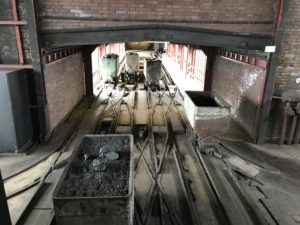 Our tour is in German. We know the guide speaks some English, because she tells us in English that she won’t tell us anything in English. Because this is not the English tour, which is Covidded off. Fortunately there is a cartoon of how coal was dug out, put on trucks and lifted to the surface 12 trucks at a time, each carrying about 12 tonnes. The trucks were then picked up on chains which took them high in the building. The chain goes over a wheel, the truck goes upside down, drops its load onto a conveyor and is taken back to the shaft to go down and get some more. The conveyor takes the winnings to be washed and sorted. Coal is then moved on bucket conveyors into hoppers, then dropped into railway wagons that passed beneath on the tracks you can see running through the site.
Our tour is in German. We know the guide speaks some English, because she tells us in English that she won’t tell us anything in English. Because this is not the English tour, which is Covidded off. Fortunately there is a cartoon of how coal was dug out, put on trucks and lifted to the surface 12 trucks at a time, each carrying about 12 tonnes. The trucks were then picked up on chains which took them high in the building. The chain goes over a wheel, the truck goes upside down, drops its load onto a conveyor and is taken back to the shaft to go down and get some more. The conveyor takes the winnings to be washed and sorted. Coal is then moved on bucket conveyors into hoppers, then dropped into railway wagons that passed beneath on the tracks you can see running through the site.
 Perhaps the conveyor belt is conveyance of the day, or maybe the trucks on chains, or this pedal powered kart on rails? S has voted for the kart.
Perhaps the conveyor belt is conveyance of the day, or maybe the trucks on chains, or this pedal powered kart on rails? S has voted for the kart.
From here much of the coal went to the Krupp steel works. Why was this not all bombed to bits? The RAF bombed at night. Krupps made a pretend works a few kilometres in the wrong direction with gasometers and towers which at night looked slightly like the real thing but with poor blackout discipline. The RAF did not twig until 1943 by which time it had attracted more than 2/3 of what was intended for the real thing. Ingenious, but no sticker for Kindness. The mine complex, some way from Krupps, came through untouched, the most beautiful mine in the world. And because it was in the US zone in 1945 it was not carted away to Russia so German and Turkish miners could power the Economic Miracle.

We go to have a look at the vast coking plant. There were plans to sell that to China but it’s still there, hosting a photographic exhibition.
The whole complex is Ingenious but is it Kind? We think so, because they have transformed it into a venue for small artistic/engineering enterprises, for large-scale exhibitions, for massive outdoor events and for promotion of a green/clean-up agenda.
Eventually even Sid and Doris will tire of industrial archaeology. We make for a small town to refill Hermann and have cafe lunch before a dash across Holland. As we record our particulars on yet another cafe log sheet a woman on the next table fills hers in using her own pre-printed stickers with all her details – another Covid merchandising opportunity is born.
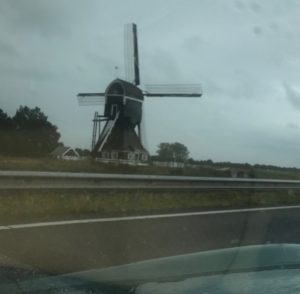 We must not stop in Holland (even to look at the windmill) or all the good work of the German CoVID precautions will be undone, with 14 days UK quarantine as the prize.
We must not stop in Holland (even to look at the windmill) or all the good work of the German CoVID precautions will be undone, with 14 days UK quarantine as the prize.
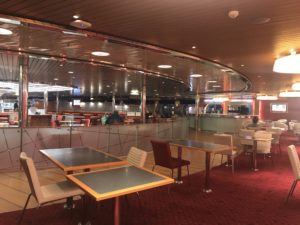
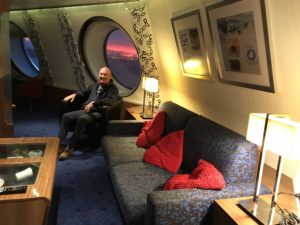
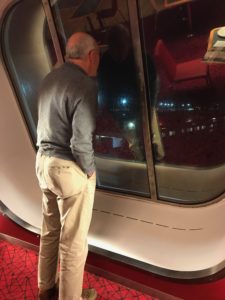 We do not get out of the car until on the Hollandica, a giant Stena ferry with almost no one on it. As a result Doris has been able to book the Captain’s Suite. It is at the front with views forward and to starboard, which keeps Sid happily busy watching the undocking and the docking.
We do not get out of the car until on the Hollandica, a giant Stena ferry with almost no one on it. As a result Doris has been able to book the Captain’s Suite. It is at the front with views forward and to starboard, which keeps Sid happily busy watching the undocking and the docking.
The run home from Harwich immediately puts us in mind of our route out to Istanbul. And so home after 2,500 miles, seeing wonderful places in a time with few tourists.
Back home to shops without masks, hand sanitiser or customer logging – thank heavens the UK has a world-class Covid system. We have a lot of good habits to unlearn.
